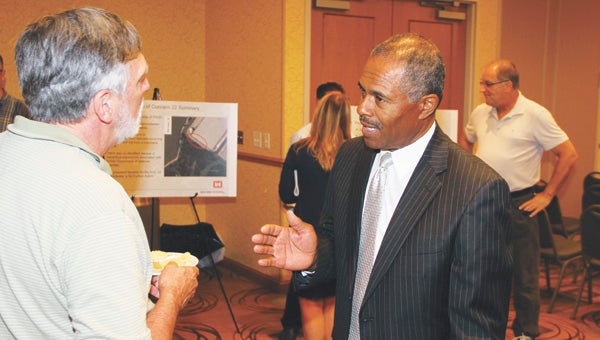Corps advances North Suffolk cleanup
Published 10:52 pm Friday, July 11, 2014

During a public meeting at the North Suffolk Hilton Garden Inn on Thursday, Respass Beach resident Bruce Johnson discusses plans for the 975-acre Former Nansemond Ordnance Depot with Greg Byrd from Suffolk’s economic development department. (U.S. Army photo by Gerald Rogers)
The U.S. Army Corps of Engineers will seek public input on its plans to close out environmental investigations and cleanup activities in three locations at a former defense site in North Suffolk.
Between 1917 and 1928, the Army acquired 975 acres at the end of College Drive. Referred to by the Corps as the Former Nansemond Ordnance Depot, various munitions-related activities there included storing ammunition to be shipped overseas during both world wars.
In 1960, the facility was deactivated and given to a charitable foundation to become a boys’ military school. Subsequently, most of it was given to the state.
Before it was practically unused for the past several years, a portion was a Tidewater Community College campus, and there are and have been various other uses and owners.
The EPA placed the site on its National Priorities List in 1999.
“We have spent over $56 million so far with the cleanup program,” said Sher Zaman, overseeing the operation. “It started in 1988 when they found TNT at the (college) campus.”
Dozens of “areas of concern” are being systematically probed. The Corps hosted a public meeting at the North Suffolk Hilton Garden Inn on Thursday to discuss its plans for three of them.
For two of the three — “Area of Concern 22,” covering a small portion of a former General Electric facility, and “Impregnite Kit Area,” a quarter-acre in the site’s western portion — no action is proposed.
Deborah McKinley, a Corps environmental engineer, said that’s because the arsenic discovered is part of a process occurring naturally, for one of the sites, and for the other because the risk is acceptable.
The latter site was used for the disposal of World War II impregnite kits, which were used to “impregnate” clothing with “impregnite powder” — also known as XXCC3 — to protect against chemical weapons.
After the soil portion was closed out several years ago, groundwater risk there was above accepted limits for carcinogens and adverse noncarcinogenic health effects. But for one chemical, BEHP, McKinley said this was due to the investigation itself, not previous activities at the site.
“We determined it had come from the latex gloves that were used for the sampling,” she said. “We don’t normally see that in the groundwater.”
The way the groundwater moves meant the other two other chemicals found, antimony and thallium, didn’t come from the area investigated, she explained.
For the third area the Corps has proposed a plan to close out, soil would be removed and disposed at an appropriate landfill, McKinley said.
There would also be limited debris removal, she said, lowering the cost from full debris removal.
Horseshoe Pond, as the area is known, is a 10-acre site on the western boundary. For about 10 years from the late 1940s, the pond was apparently occasionally used for waste disposal.
Chemical levels found in groundwater, surface water and sediment were at levels warranting no further action, but four compounds found in the soil presented an unacceptable risk with condos set to infringe upon the site. Contamination could also potentially impact the American robin, McKinley said.
Technical documents and reports for the draft plans are available to view at North Suffolk Library, and the draft plans and a fact sheet are online at www.nao.usace.army.mil/.
Public comments will be accepted through July 30. Written comments can be directed to Sher Zaman, Project Manager, U.S. Army Corps of Engineers, Baltimore District, P.O. Box 1715, Baltimore, MD 21203-1715, or email sher.zaman@usace.army.mil.
McKinley hopes a record of decision detailing the remedial action — or no action — and including responses to comments will be formed by the end of September.
Zaman said that a contractor has already started the design process for Horseshoe Pond and should be done by December.
To complete the project, about $3 million has been requested from Congress for next fiscal year, he said.
“We start the removal action next year,” he said. “We are hoping that it might be done sometime next year.”





